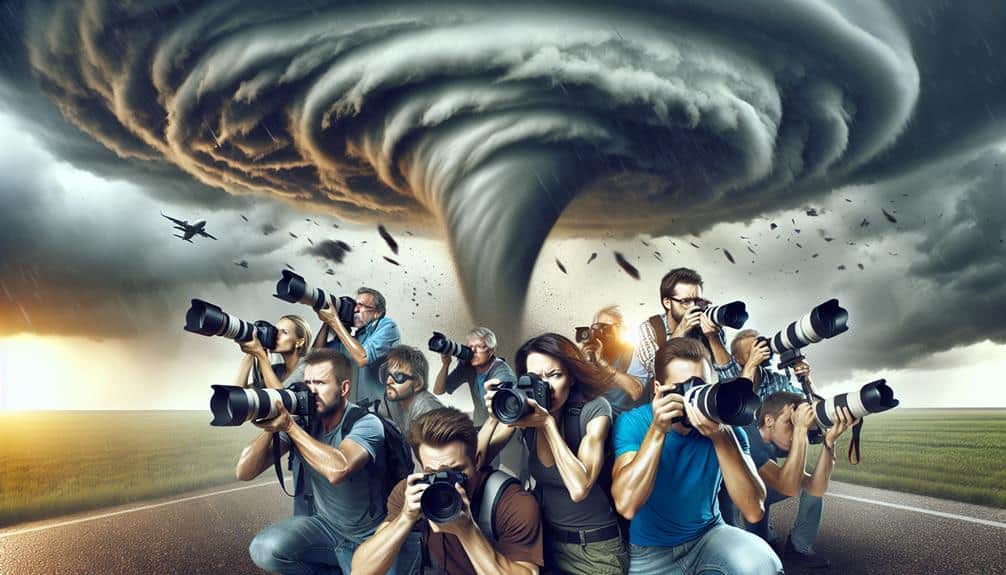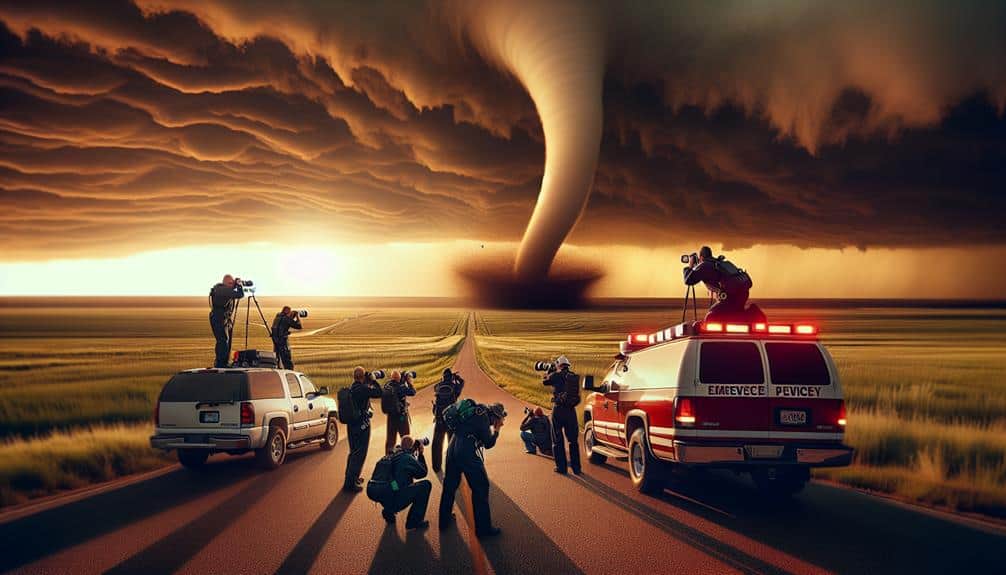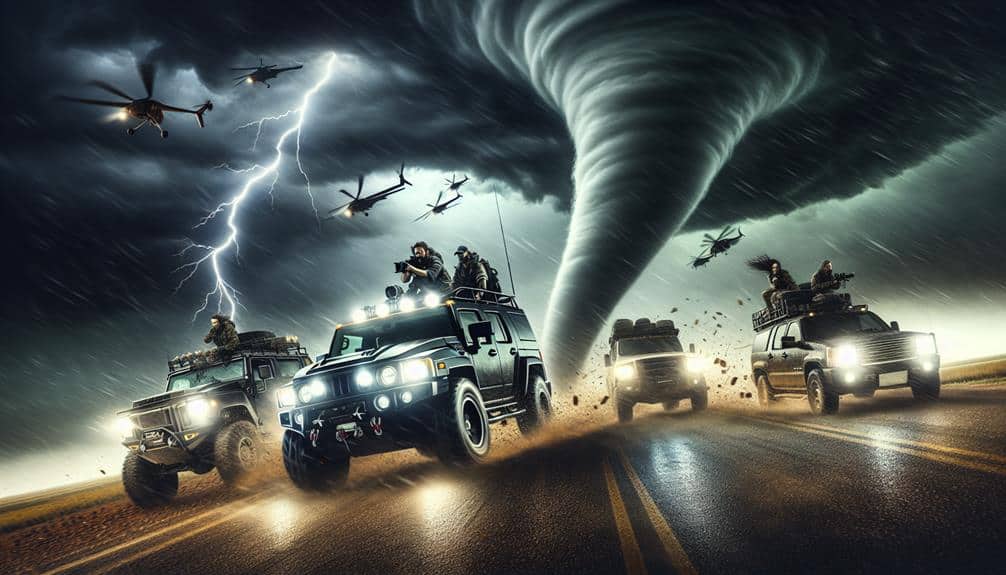We must strengthen storm chaser news reporting by integrating safety protocols, using GPS systems, and staying prepared for rapid weather changes. Verifying sources with triangulation methods and radar imagery guarantees credibility. High-quality equipment and drone usage enhance visual storytelling, while collaborating with meteorologists sharpens forecasting. Streamlined field communication and maintaining ethical standards are crucial. Real-time updates through Doppler radar and social media enhance audience engagement. Highlighting the human impact fosters relatability, and employing advanced meteorological tools improves accuracy. If we implement these strategies, our storm reporting will reach new levels of precision and impact.
Key Points
- Utilize high-quality equipment and drones for capturing vivid and dramatic storm imagery.
- Prioritize human impact stories and share personal narratives to enhance relatability.
- Employ advanced meteorological tools like Doppler radar and satellite imagery for precise storm tracking.
- Adhere to safety protocols and maintain a safe distance from storm cores.
Prioritize Safety Precautions
In storm chasing, we must rigorously adhere to safety protocols to mitigate the inherent risks involved. Storm chasing can be exhilarating, but it's essential we prioritize our safety and that of our crew. Establishing robust emergency preparedness plans is non-negotiable. We start by ensuring our vehicles are equipped with essentials like first aid kits, water supplies, and communication devices. These protocols aren't just guidelines; they're lifelines.
Our data-driven approach mandates regular checks on weather updates, road conditions, and potential hazards. We use GPS systems and storm tracking software to stay informed. During a chase, maintaining a safe distance from the storm's core is paramount. The National Weather Service recommends staying at least one mile away from the storm's path, but we often extend this buffer to two miles for added caution.
We've got to be prepared for rapid changes in weather conditions. Quick decision-making based on real-time data can save lives. Emergency preparedness also involves having a designated safe zone and evacuation routes pre-planned.
In storm chasing, freedom comes with responsibility. By strictly following safety protocols and being well-prepared for emergencies, we enhance our ability to safely capture the raw power of nature.
Verify Information Sources
We must rigorously cross-check all information sources to verify the accuracy and reliability of our storm reports. When analyzing data from various sources, we need to evaluate credibility by considering the origin of the information. Is it coming from a recognized meteorological institution, an experienced storm chaser, or an unverified social media account? Each source carries different weights concerning reliability.
We should employ triangulation methods to confirm accuracy. By comparing multiple independent reports, we can identify inconsistencies and corroborate critical details. This approach minimizes the risk of disseminating erroneous data, which could undermine our credibility and misinform our audience.
Utilizing specialized tools such as radar imagery, satellite data, and ground reports allows us to cross-reference information effectively. We must also remain vigilant about the timestamps and geolocation of incoming data, ensuring that our reports are both timely and geographically precise.
In a field where quick decisions and rapid dissemination of information are paramount, maintaining data integrity is essential. By prioritizing the evaluation of credibility and confirming the accuracy of our sources, we uphold the trust and freedom of our audience to make informed decisions based on our storm reports.
Enhance Visual Storytelling
To improve our visual storytelling, we should use high-quality equipment and capture dramatic angles. High-resolution cameras and stabilized rigs guarantee our footage is both clear and dynamic.
Utilize High-Quality Equipment
High-quality equipment consistently enhances visual storytelling by capturing detailed and vivid imagery essential for impactful storm chaser news reporting. It's evident that maintaining our equipment is crucial, particularly given the harsh environments we operate in.
Advanced cameras with high dynamic range (HDR) sensors, durable tripods, and stabilized gimbals make sure crisp, clear footage even in the most turbulent conditions. However, we must balance this need with budget constraints. Investing in reliable gear upfront often saves us from costly repairs and replacements down the road.
Technology advancements continually push the boundaries of what's possible. Modern drones equipped with 4K cameras allow us to capture sweeping aerial views of storm formations, while portable weather stations provide real-time meteorological data.
Nonetheless, the field challenges we face are significant. Unpredictable weather conditions and rough terrains test the limits of our equipment.
Capture Dramatic Angles
Leveraging the capabilities of our advanced equipment, capturing dramatic angles becomes a pivotal strategy in enhancing visual storytelling in storm chaser news reporting.
By integrating drone footage into our repertoire, we gain the ability to document extreme weather from perspectives previously unattainable. These aerial views provide a thorough understanding of storm systems, showcasing their scale and intensity in unparalleled detail.
Drones allow us to navigate the periphery of dangerous systems safely, capturing high-resolution images and video without putting ourselves at risk. This technology enables us to document phenomena such as tornadoes, hurricanes, and supercell structures from vantage points that ground-based equipment simply can't achieve.
The dynamic angles and sweeping panoramas not only enhance our storytelling but also deliver a visceral, immersive experience for our audience, satisfying their quest for freedom and exploration.
Use Reliable Equipment
When chasing storms, making sure we've got dependable equipment is vital for both safety and accurate data collection. We can't afford gear failures when documenting severe weather; equipment maintenance is pivotal. Regularly checking and servicing our cameras, drones, and meteorological instruments guarantees that they function correctly when we need them most. By prioritizing gear reliability, we're not just securing our safety, but also ensuring the integrity of our data.
Our cameras should be equipped with high-resolution sensors and stabilized mounts to capture clear, detailed footage even in turbulent conditions. Drones need to have advanced GPS and obstacle-avoidance systems to navigate safely through storm environments. Additionally, meteorological instruments, such as anemometers and barometers, must be regularly calibrated to provide precise measurements.
Moreover, power sources are an essential component of our operational readiness. High-capacity, weather-resistant batteries should be a staple in our toolkit, guaranteeing our devices remain operational throughout our chase. Backup power solutions like solar chargers or power banks are indispensable, providing an extra layer of reliability.
In essence, by committing to rigorous equipment maintenance and selecting gear known for its dependability, we're empowering ourselves to capture the most compelling and accurate storm data possible, all while maintaining the freedom to explore nature's most extreme phenomena.
Collaborate With Meteorologists

Collaborating with meteorologists enhances our ability to predict storm patterns more accurately and make informed decisions during our chases. By leveraging the expertise of meteorologists, we gain access to precise weather forecasting models that provide essential data on storm trajectories, intensities, and potential impact zones. This collaboration enables us to pinpoint high-risk areas, optimizing both our time and safety.
Meteorologists utilize advanced tools like Doppler radar, satellite imagery, and computer simulations to offer real-time updates. These resources are invaluable for our decision-making process, allowing us to adapt our strategies on the fly. For instance, when a supercell shows signs of rotation indicative of tornado formation, timely meteorological input can guide our positioning to capture crucial footage while ensuring our safety.
Furthermore, our partnership with meteorologists plays a vital role in emergency response. Accurate weather forecasting helps emergency services prepare and respond more effectively to impending disasters. By sharing our on-the-ground observations and footage, we provide meteorologists with additional data points to refine their models, creating a symbiotic relationship that enhances overall storm tracking accuracy and public safety.
In essence, this collaboration not only enriches our storm chasing endeavors but also contributes significantly to the broader emergency response framework, underscoring the importance of precise, data-driven weather forecasting.
Focus on Human Impact
We need to prioritize the human impact by sharing personal stories and highlighting community efforts in our storm chaser reporting.
By presenting qualitative data and firsthand accounts, we can effectively humanize the statistics and underscore the resilience of affected populations.
This approach not only informs but also engages our audience on a deeper emotional level.
Highlighting personal stories of those affected by storms provides a profound understanding of the human impact, turning abstract data into relatable, compelling narratives. By focusing on emotional connections and utilizing storytelling techniques, we bring the raw human experience to the forefront. This approach allows our audience to engage deeply with the material, fostering empathy and awareness.
When we share personal anecdotes, we must make sure that we maintain journalistic integrity. This involves verifying the accuracy of the stories and presenting them in a balanced manner. We should aim to capture the full spectrum of experiences, from survival to recovery, emphasizing resilience and strength.
Data-driven reporting can still be enriched with these personal elements. Including quotes, firsthand accounts, and visual storytelling helps to contextualize statistical information, making it more accessible and impactful. Our goal is to create a narrative that resonates on a human level, while still grounded in factual accuracy.
Highlight Community Efforts
By turning our attention to community efforts, we can underscore the collective resilience and ingenuity that emerges in the face of natural disasters. We need to focus on volunteer initiatives, which demonstrate the power of grassroots mobilization. When we report on these initiatives, we highlight how local residents step up, showcasing their commitment to recovery and support.
Fundraising events are another key aspect we should cover. These events not only provide critical financial resources but also foster a sense of unity and shared purpose. By reporting on successful fundraising events, we can offer data-driven insights into their impact on disaster recovery.
Community partnerships and outreach programs are essential to the overall resilience strategy. We should emphasize how these alliances between local organizations, businesses, and government agencies contribute to coordinated response efforts. By detailing specific outreach programs, we can illustrate how targeted support services mitigate the human impact of storms.
In our reporting, we must present technical accuracy and leverage specialized language to convey the effectiveness of these efforts. Highlighting these community-driven responses not only informs but empowers our audience, fostering a culture of preparedness and mutual aid. With every story, we champion the freedom and capability of communities to rise above adversity.
Streamline Field Communication
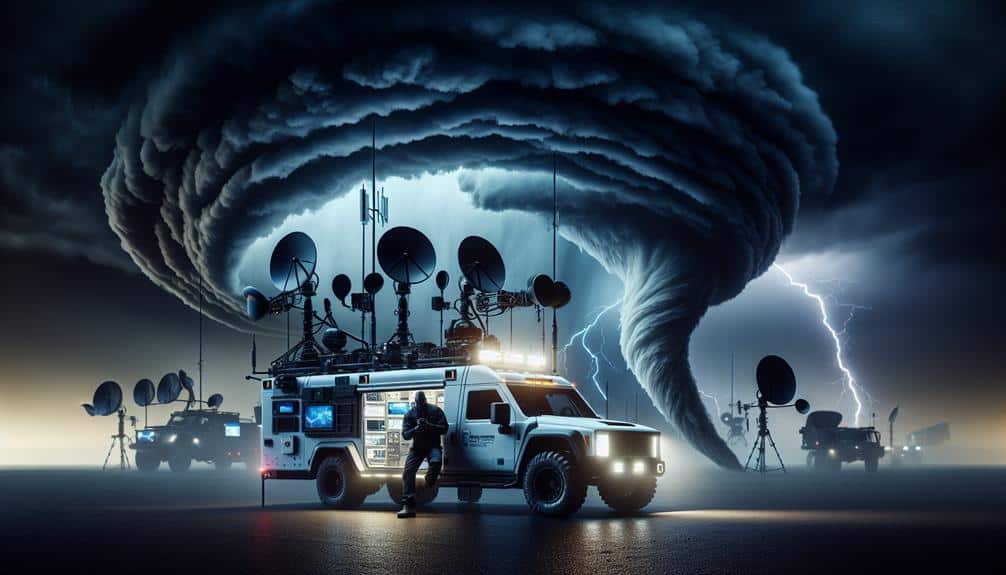
Effective field communication relies on utilizing robust, real-time data transmission systems to guarantee accurate and timely information exchange among storm chasers. It's crucial that field coordination and technology integration are paramount. By leveraging advanced communication tools, we can make sure our teams are synchronized and responsive.
Communication efficiency is crucial. Using high-bandwidth mobile hotspots and satellite communication can bridge gaps in connectivity. Data analysis tools, integrated with our communication systems, enable us to interpret and disseminate meteorological data swiftly. This allows us to make informed decisions in the field, reducing response time and enhancing safety.
To streamline our communication, we should focus on:
- Unified Communication Platforms: Integrate voice, video, and data channels into a single platform, making it easier to share updates and visual data in real-time.
- Automated Alerts: Utilize systems that send automatic warnings based on weather data, ensuring everyone is promptly informed of critical changes.
Maintain Ethical Standards
When we report on storm events, we must verify information sources to guarantee data accuracy and integrity.
We should also respect privacy boundaries by obtaining consent before capturing personal details or images.
Upholding these ethical standards is critical to maintaining public trust and professional credibility.
Verify Information Sources
Assuring the credibility of our storm reports requires that we meticulously cross-check information from multiple reliable sources to maintain ethical standards. It's essential that we don't just take initial data at face value. Cross-checking facts and evaluating credibility are fundamental to delivering accurate and trustworthy storm reports.
To achieve this, we should:
- Consult multiple data sources: Use radar data, satellite imagery, and ground observations to corroborate the information.
- Verify eyewitness accounts: Cross-reference with official meteorological reports and other eyewitnesses to validate consistency.
By diligently following these steps, we enhance our reporting accuracy and uphold ethical standards.
For instance, when we consult radar data, we can compare it with satellite imagery to detect discrepancies.
Cross-referencing eyewitness accounts with official meteorological data helps authenticate the authenticity of the information.
Evaluating the credibility of sources ensures we're not misled by unreliable or biased information.
Respect Privacy Boundaries
Respecting privacy boundaries is essential in storm chaser news reporting to maintain ethical standards and protect individuals' personal information. We need to balance our commitment to delivering timely and accurate news with privacy considerations. This involves obtaining explicit consent before capturing or broadcasting footage that includes private property or individuals in distress.
Journalistic ethics dictate that we avoid sensationalism and respect the boundaries of those affected by severe weather events. When we approach a storm-damaged area, it's vital to remember that these spaces are often the epicenters of personal tragedy. Intruding without permission can exacerbate an already traumatic situation for those involved. Hence, our consent protocols should include clear communication and documented approval.
Data shows that respecting privacy not only upholds our ethical standards but also fosters trust with our audience. By adhering to privacy considerations, we guarantee our reporting is both responsible and reliable. Technology, like drone footage, should be used judiciously, keeping in mind the privacy of individuals.
Establishing these boundaries isn't just about compliance; it's about showing respect for human dignity in the face of disaster. Let's commit to ethical journalism that values both information and individual privacy.
Provide Real-Time Updates
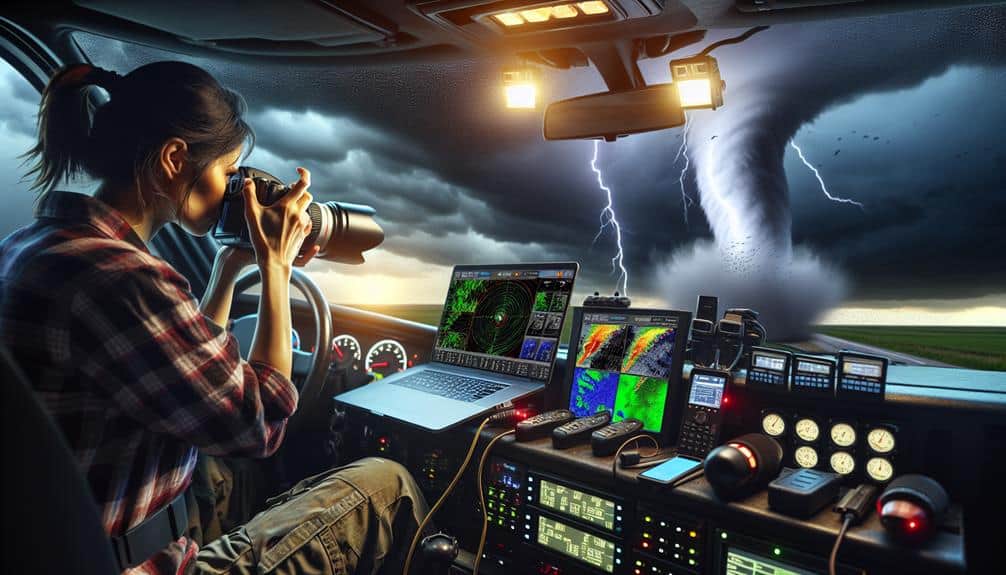
Delivering real-time updates demands the smooth integration of advanced meteorological tools and rapid communication channels. We need to harness technology that provides us with precise, minute-by-minute weather data. Utilizing platforms like Doppler radar, satellite imagery, and storm tracking software guarantees that our information is both accurate and timely.
This real-time data must then be swiftly communicated to the public through various channels. Social media plays a vital role here. Platforms like Twitter and Facebook allow us to disseminate updates quickly and reach a broad audience. Live streaming on these platforms enables us to show real-time footage, adding a layer of transparency and immediacy.
Additionally, citizen journalism can enhance our coverage. By encouraging locals to share their observations and experiences, we can gather a more thorough picture of the storm's impact.
- Employ advanced meteorological tools: Use Doppler radar and satellite imagery for precise tracking.
- Harness social media: Use Twitter, Facebook, and live streaming for rapid information dissemination.
Improve Audience Engagement
To enhance audience engagement, we must leverage interactive tools like live polls, Q&A sessions, and user-generated content to foster a dynamic and participatory experience. By integrating these interactive features, we create a sense of community engagement that makes our audience feel involved and valued.
Utilizing social media platforms is essential to this strategy. Live streaming on platforms such as Facebook Live, YouTube, and Instagram can offer real-time updates while simultaneously inviting viewer interaction. During these live streams, we should incorporate live polls to gauge audience sentiment and drive engagement. Q&A sessions can provide immediate responses to viewer queries, enhancing the interactive experience and building trust.
Moreover, user-generated content can significantly boost community engagement. Encouraging viewers to share their own storm footage or experiences via hashtags not only provides us with valuable on-the-ground information but also fosters a sense of ownership among our audience. This user-generated content can be highlighted during live streams, further strengthening the community bond.
Data analytics from these social media interactions can provide insights into audience preferences and behaviors, enabling us to fine-tune our approach for even greater engagement. In this way, we create a more responsive, interactive, and community-driven news reporting model.
Frequently Asked Questions
How Do Storm Chasers Typically Fund Their Expeditions?
We typically fund our expeditions through diverse funding sources like sponsorships, grants, and personal savings. Financial challenges arise due to the unpredictable nature of storms, requiring flexible budgets and innovative financial strategies to guarantee operational freedom.
What Qualifications Are Needed to Become a Professional Storm Chaser?
To become a professional storm chaser, we need a strong educational background in meteorology or atmospheric science, coupled with extensive field experience. Advanced data analysis skills and knowledge of meteorological equipment are also essential for success in this field.
What Are the Most Common Misconceptions About Storm Chasing?
When the storm's fury becomes our dance floor, people often think we ignore safety measures. In reality, we rely on advanced equipment and meticulous planning. Public perception underestimates the risks and overestimates the thrill of storm chasing.
How Do Storm Chasers Prepare for Unpredictable Weather Conditions?
We always prioritize safety precautions and maintain a stock of emergency supplies. Our team relies on real-time atmospheric data, advanced meteorological models, and GPS tracking to navigate unpredictable weather, ensuring both our safety and the accuracy of our reports.
What Are the Legal Regulations for Storm Chasing in Different Regions?
We need to take into account legal restrictions and safety guidelines for storm chasing, which vary by region. Some areas require permits or adherence to specific protocols to guarantee both our safety and compliance with local regulations.
